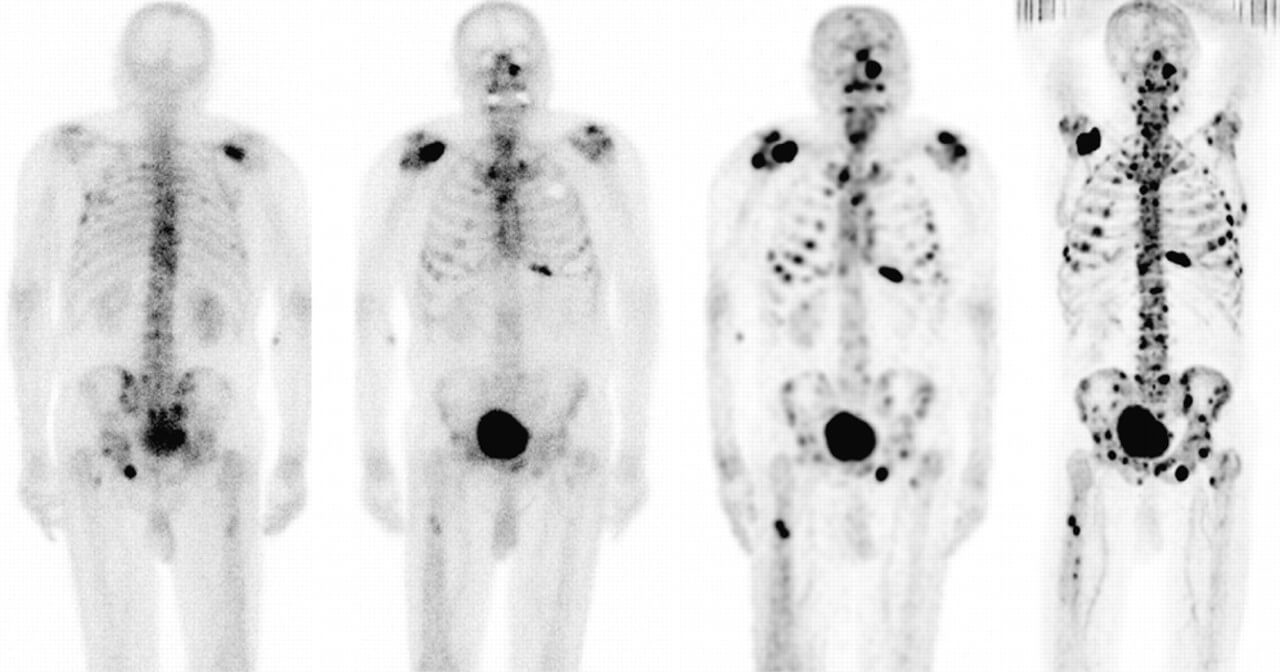Calls for Ukraine
Calls for Europe
Calls for USA

Metastatic (secondary) bone cancer refers to tumors that originate in other tissues and spread (metastasize) to the bone. The rich arterial blood supply to the bones makes them one of the most frequent areas of metastasis localization. In fact, the skeleton is the third most common site of injury after the lungs and liver. The most common bone metastases are: breast cancer, prostate cancer, lung cancer, kidney cancer, and thyroid cancer.
Metastatic bone disease causes very severe pain. It may be associated with structural damage to bone tissue or inflammation, which provokes a malignant process. Sometimes the pain is caused by broken bones.
Effective pain relief for bone metastases is one of the main goals of the treatment. To alleviate the condition of patients, doctors recommend the following:
The choice of therapeutic tactics or painkillers for bone metastases depends on the location and stage of the secondary foci of the disease. A doctor will select the most effective treatment method based on the results of the diagnostic examination.
Unfortunately, it is impossible to stop the process of bone metastasis if it has already begun. Methods such as chemotherapy, radiation therapy, targeted therapy and immunotherapy help slow the progression of the disease and improve the quality of life of patients. However, few people know that there are ways to help prevent the development of bone metastases. One of them is vaccine therapy.
Scientists from Ukraine have found a double solution to this problem. They used embryonic quail proteins, which contain antigens similar to those present in cancer cells. To enhance the immune response, antigens are biotransformed under the influence of cytotoxic proteins B. subtilis B-7025. After the introduction of the vaccine, an immune response is formed in the patient’s body. Simply put, the immune system begins to fight the tumor itself, destroying cancer cells and preventing their spread. The new drug is called the cancer xenovaccine CANCERAX.

Clinical studies have shown that the use of Cancerax xenovaccine can slow down tumor growth (by 50-90%) and significantly reduce the likelihood of distant metastasis. An important fact is that xenovaccine is effective even in the presence of a significant tumor mass in the body, while autovaccines (made from the patient’s biological material) act only after surgical removal of the tumor.
The MedTour company will help to select an affordable clinic for patients from any country in the world, where it is possible to take a course of immunotherapy with CANCERAX xenovaccine. We will deliver the drug to an accessible medical center in compliance with all storage and transportation standards. To learn more about the innovative method of cancer treatment and prevention, get a consultation from the medical coordinator of MedTour.
To choose the best doctor and sign up for a consultation at the clinic, leave a request on the MedTour website. The coordinating doctor will help you with the choice of a specialist and select the best clinic according to your wishes.
Metastatic bone disease can cause the following symptoms:
Any symptoms described above should be reported to the doctor. Currently, there are modern methods of treatment that help to alleviate the patient’s condition and improve his quality of life.
For the diagnosis of metastatic bone cancer, the following instrumental studies are most often used:

Bone scintigraphy continues to be the most widely used radionuclide method for the study of skeletal metastases, primarily due to the fact that it is an effective and affordable technique.
During the study, a small amount of a radiopharmaceutical is administered intravenously to the patient. The drug enters the bloodstream and is absorbed by the bone tissue, which allows the affected areas to be visualized on an x-ray.
The main advantage of radionuclide bone scanning is that the whole skeleton can be imaged with this technique. This is important given that metastatic lesions can occur in areas of the appendicular skeleton (bones of the extremities) that are not usually examined by other diagnostic methods.
Another advantage is associated with the high sensitivity of scintigraphy, which makes it possible to detect bone metastases at an early stage. The sensitivity and specificity of bone scintigraphy is 78% and 48%, respectively. According to studies, in order to detect pathological foci, it is enough that the ratio of the affected bone to the normal one is only 5-10%. Accordingly, osteoscintigraphy allows diagnosing sclerotic metastases 18 months earlier than conventional x-rays.
MedTour company cooperates with the best diagnostic centers in the world. Call or write to us to find the best clinic for the diagnosis of bone metastases using modern research methods.
Laboratory tests are used as an aid in the diagnosis of metastatic bone cancer. Patients may have a blood test for alkaline phosphatase levels (increased when cancer spreads to the bone). Blood tests also help identify a condition called hypercalcemia, which is common with bone metastases.

The main goals of therapy for metastatic bone cancer are to preserve the patient’s quality of life, relieve pain, minimize the risk of fractures, and achieve local tumor control when possible.
Pain relief
Relief of the debilitating pain that is often present in patients with bone metastases is one important aspect of the overall treatment strategy. The therapeutic protocol may include the use of various drugs, such as: NSAIDs (non-steroidal anti-inflammatory drugs), glucocorticosteroids, opioids, osteoclast inhibitors.
Radiation therapy
Radiotherapy helps relieve the pain of bone metastases. This method of treatment is also used in the postoperative period to improve bone healing. External radiation therapy is standard. Many modern cancer centers around the world also use a method of irradiation that is more gentle on the surrounding tissues – stereotaxic surgery. It targets the pathological focus with a high dose of radiation.
Chemotherapy
Chemotherapy drugs are usually used to treat the underlying tumor. Chemotherapy helps reduce the pain of bone metastases by reducing the size of the primary tumor and controlling the spread of cancer cells.
Surgery
Prophylactic or stabilizing surgery is indicated when long bones are at risk or have already fractured to provide mechanical stability and preserve the function of the affected body part. If the tumor is putting pressure on the spinal cord, doctors perform surgical decompression and stabilization of the spine. In cases where the spread of the primary cancer is limited (single bone lesion), doctors consider resection of the metastasis as a means of local control of the tumor.
Most patients with bone metastases live for 6-48 months. However, these are very generalized figures. Life expectancy can vary greatly depending on several factors, including the type and stage of the primary cancer, the general health of the patient, the presence of metastases elsewhere in the body, and the availability and response to effective treatment.
If bone metastases are detected at an early stage and controlled with appropriate treatment, the patient’s life expectancy is comparable to the prognosis for the underlying cancer.
The MedTour company cooperates with the world’s leading cancer centers that specialize in the diagnosis and treatment of metastatic bone cancer. Currently, there are modern therapeutic methods that help control the spread of cancer and maintain a high quality of life for patients. Call the number listed on the website or fill out the feedback form to get a free consultation from the MedTour coordinating doctor. Our specialist will help you choose the best clinic and doctor, as well as resolve all issues related to the organization of treatment.
On the MedTour platform, you can find information about the world’s leading oncologists specializing in the treatment of bone metastases. Our doctor-coordinator will help you choose the best specialist, taking into account your personal needs and wishes.
Please rate the work of MedTour
